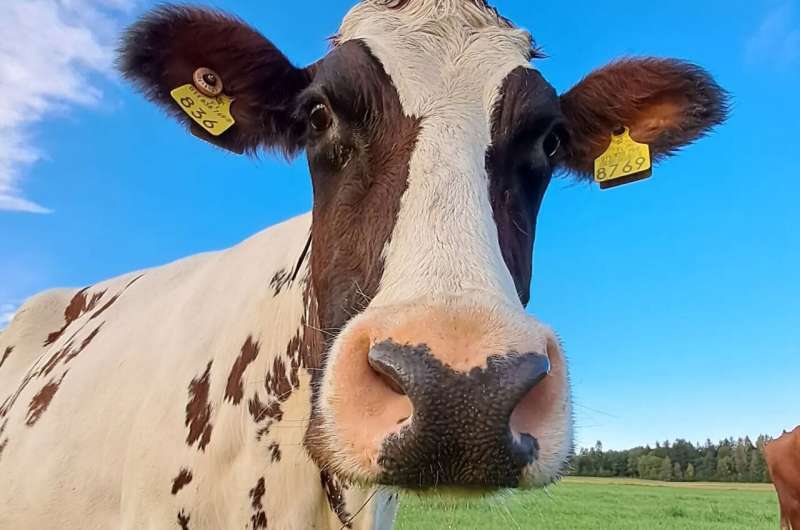Science
Microplastics Disrupt Farm Animal Gut Health, Study Finds

Microplastics, tiny particles commonly found in agricultural environments, have been shown to disrupt the gut microbiome and fermentation processes in farm animals, according to a comprehensive study involving multiple European institutions. This research, which appears in the Journal of Hazardous Materials, highlights the biological consequences of microplastic exposure in livestock.
Lead researcher Daniel Brugger, an Associate Professor at the University of Helsinki, emphasized the urgency of conducting in-vivo studies to better understand the implications for animal health and food safety, particularly as global plastic production continues to rise.
Key Findings of the Research
The collaborative study included researchers from the University of Zurich, University of Hohenheim, and Technical University of Munich. Using a controlled laboratory fermentation system, they examined the effects of five common microplastics—polylactic acid (PLA), polyhydroxybutyrate (PHB), high-density polyethylene (HDPE), polyvinyl chloride (PVC), and polypropylene (PP)—on rumen fluid from cattle. These microplastics were tested in various forms to assess their impact on fermentation and microbial activity.
The findings revealed that all tested microplastics interacted with the rumen microbiome, significantly altering fermentation processes. Notably, the presence of microplastics led to a consistent reduction in cumulative gas production, a key indicator of fermentation activity. This decline occurred irrespective of the type, size, or dosage of plastic used during the experiments.
Furthermore, the study observed an increase in total dry-matter disappearance with microplastic addition. This suggests that not only feed but also portions of the microplastic mass were broken down during fermentation, potentially reducing their size and increasing the risk of tissue penetration in animals.
Implications for Animal Health and Food Safety
The study addresses a critical gap in understanding how microplastics behave within the digestive systems of farm animals. Previous research established that livestock are exposed to microplastics through contaminated feed and soil, but it was unclear whether these particles remained unchanged or interacted with the gut microbiome. Professor Jana Seifert of the University of Hohenheim noted, “This means farm animals are not passive recipients of plastic pollution; their digestive systems may act as bioreactors that transform microplastics.”
The findings raise significant concerns regarding the health and productivity of farm animals. A disrupted microbiome could lead to decreased efficiency and overall health. Additionally, smaller fragments of plastic generated during digestion may be more easily absorbed into animal tissues, posing potential risks to the human food chain, particularly for young or stressed animals with more permeable intestinal barriers.
To mitigate these risks, the researchers advocate for improved management of plastic usage in agriculture. This includes addressing the use of silage films, packaging materials, and contamination from sewage sludge in fields.
Professor Cordt Zollfrank, from the Technical University of Munich, underscores the urgency of addressing plastic pollution as it has direct biological consequences for farm animals and potentially humans through the food chain.
The research provides a scientific basis for future risk assessments and monitoring. With experimental evidence of microplastics interacting with the rumen microbiome, regulators and veterinarians can better define acceptable contamination levels and develop detection methods for plastics in feed and animal products.
As the study opens avenues for further investigation, Brugger remarked on the potential for future research to expand into non-ruminant species, such as pigs, which still requires verification.
This pivotal research lays the groundwork for understanding the complex interactions between microplastics and farm animal health, emphasizing the need for sustainable practices to protect both animal welfare and food safety.
-

 Lifestyle4 months ago
Lifestyle4 months agoLibraries Challenge Rising E-Book Costs Amid Growing Demand
-

 Sports4 months ago
Sports4 months agoTyreek Hill Responds to Tua Tagovailoa’s Comments on Team Dynamics
-

 Sports4 months ago
Sports4 months agoLiverpool Secures Agreement to Sign Young Striker Will Wright
-

 Lifestyle4 months ago
Lifestyle4 months agoSave Your Split Tomatoes: Expert Tips for Gardeners
-

 Lifestyle4 months ago
Lifestyle4 months agoPrincess Beatrice’s Daughter Athena Joins Siblings at London Parade
-

 World4 months ago
World4 months agoWinter Storms Lash New South Wales with Snow, Flood Risks
-

 Science3 months ago
Science3 months agoSan Francisco Hosts Unique Contest to Identify “Performative Males”
-

 Science4 months ago
Science4 months agoTrump Administration Moves to Repeal Key Climate Regulation
-

 Business4 months ago
Business4 months agoSoFi Technologies Shares Slip 2% Following Insider Stock Sale
-

 Science4 months ago
Science4 months agoNew Tool Reveals Link Between Horse Coat Condition and Parasites
-

 Sports4 months ago
Sports4 months agoElon Musk Sculpture Travels From Utah to Yosemite National Park
-

 Science4 months ago
Science4 months agoNew Study Confirms Humans Transported Stonehenge Bluestones









